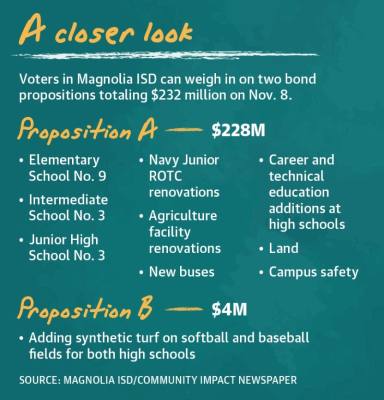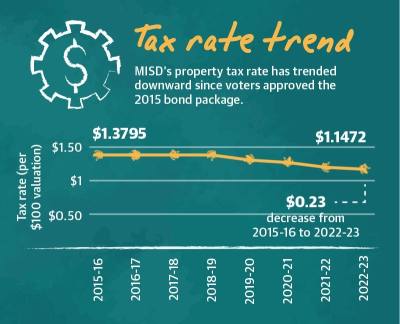The board approved a bond package at the Aug. 8 meeting that includes funds to build new schools, expand space for career and technical education programs, purchase new buses and add synthetic turf to fields at the high schools, among other projects.
Loretta Blendermann, a Realtor in Magnolia and parent of former MISD students, said in an interview she believes the bond is necessary to serve new students from the influx of subdivisions, such as Audubon and Escondido.
“Over the next few years we are going to have numerous [students] going to high school,” Blendermann said. “It’s not only going to affect our elementary schools, ... it’s going to affect all of them.”
Assistant Superintendent of Operations Erich Morris said the bond would not require a tax rate increase; the board approved a $0.04 tax rate decrease in August for fiscal year 2022-23.
Denise Meyers, executive director of communications and public relations, said in an interview that all campuses are seeing enrollment rise rapidly, which is overcrowding facilities and creating the need for more career and technical education space. MISD officials said another bond—which could include a third high school—will likely be called in the near future to accommodate the rapid growth.
MISD is projected to enroll more than 17,200 students by the 2026-27 school year, according to a spring 2022 demographic study by Templeton Demographics, which is an increase from the 14,370 students the district projects for 2022-23.
Two propositions will be presented to voters Nov. 8. Proposition A totals $228 million for big-ticket items such as new elementary, intermediate and junior high schools; Proposition B totals $4 million for synthetic turf.
Sandy Barton, president of the Greater Magnolia Parkway Chamber of Commerce, said in an interview she believes it is important for residents to vote in the bond election.
“Some people say, ‘Well, why should I care? I don’t have a child in school.’ Well, the children that are in school now are our future leaders,” Barton said.
Enrollment growth
According to the demographic report, enrollment increased by 556 students, or 4.2%, from the 2020-21 school year to 2021-22. The report also projects MISD will enroll more than 22,000 students by the 2031-32 school year, growing 61.09% over the next 10 years.
As of the Aug. 8 meeting when the bond election was called, Deputy Superintendent Jason Bullock said some campuses—including Williams Elementary and both high schools—had outpaced enrollment projections for the 2022-23 school year before the school year began Aug. 10.
Meyers said she believes increased housing activity is bringing more students. According to the demographic study, the district has 32 actively building subdivisions and 18 future subdivisions proposed. The study shows MISD had identified 32,233 future lots for homes as of the study.
The demographic report shows neighborhoods with the most homes sold in the fourth quarter of 2021 include Audubon, Mill Creek Estates, Magnolia Ridge and Mustang Ridge.
Audubon saw the largest number of homes sold—more than 130 homes, including 42 homes sold in January, according to Meyers. The master-planned community is split between the Williams and Magnolia Parkway elementary zones.
“Some of these newer neighborhoods are coming online, and so we are starting to see enrollment growth from those neighborhoods, too,” Meyers said. To better plan for growth, MISD in August 2021 hired a long-range planning coordinator, Deanie Murry, who is tasked with analyzing growth trends within the district as well as working with developers to project future growth.
•Murry said she believes the increased mobility with the Hwy. 249 tollway extension through Magnolia as well as more residents moving from the city to the suburbs is contributing to MISD’s rising enrollment.
“I think the opening of [the tolled portion of Hwy.] 249 has opened up some properties that [have] been a little harder to get,” Murry said.
Bond proposal
Superintendent Todd Stephens presented the bond package at the Aug. 8 meeting. Proposition A includes elementary, intermediate and junior high schools; additional space at both high schools for CTE programs; renovations to the Navy Junior ROTC facility; and agriculture center renovations.
Funds would also be provided for land for future schools, new buses, maintenance, technology infrastructure and campus safety.
During a July 11 meeting, trustees added $2 million to the initial $230 million bond proposal presented in May for safety and security upgrades. Meyers said the security funds could go to items such as additional security cameras, but the specific safety needs have not yet been determined.
"I feel comfortable with a lot of the level of security enhancements we have currently in our buildings,” Stephens said Aug. 8. “But I think it’s something we have to continually keep looking at.”
According to the Aug. 8 presentation, the district’s ninth elementary school—to be named Audubon Elementary—is projected to cost $41 million and will be located within Audubon.
The third middle school is estimated to cost $66 million and be located near 11659 FM 1488, while the third junior high would cost $85 million and be located across from the Magnolia Parkway campus, according to Meyers.
She said attendance boundaries will shift to populate the new campuses.
Meanwhile, Proposition B would provide $4 million to add turf to the baseball and softball fields at Magnolia and Magnolia West high schools, according to the Aug. 8 presentation.
“If we want our schools to continue to be the kind of schools that we want all of our children to go to and get a good education, ... we need to vote in support of MISD as they continue to grow,” Barton said.
Some residents have voiced opposition to the bond. MISD resident Barry Tate said in an interview he believes it is “terrible” timing for a bond as residents see already high inflation.
“Now is not the right time to ask taxpayers to pay more for school expansion,” Tate said. “Everyone knows that due to [rising property] appraisals ... people do have a tax increase to pay for this.”
Looking ahead
Since voters approved the last bond package in 2015, the district has seen a $0.23 decrease in the tax rate from $1.3795 per $100 valuation in 2015-16 to $1.1472 for fiscal year 2022-23.
The bond package would not raise the tax rate, but Stephens said during the Aug. 8 meeting a bond increases the amount of voter-approved debt. However, MISD officials claim the district has the lowest voter-approved debt—$10,459 per student—compared to surrounding districts.
“I think we need to be truthful. ... It will raise the voter-approved debt,” Stephens said. “But it is not going to take [an] increase in our tax rate to support and pay that debt off.”
Further, Meyers said the district has the capacity to call a second bond election in the next two years without increasing the tax rate. Meyers said a committee is expected to revisit another bond proposal for the 2024-25 school year, which could include a third high school as well as allocating funds for the future construction of elementary schools and a fourth intermediate and junior high.
“Over the next several years [we’re] going to be continuing to have to put new buildings on our ground,” Stephens said.









